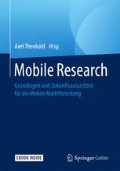Abstract
One overall aim of this chapter is to identify the prevalence rates of mixed-devices (especially smartphones and tablets) in a representative online panel survey in Germany between 2014 and 2016. Moreover, demographic and psychographic determinants of device type usage for online survey participation across time are identified, along with selected consequences of device usage on nonresponse indicators, survey duration, and evaluative judgments regarding the respective surveys. We found that a substantial share of online survey participants do actually use mobile devices, and that nonresponse is most pronounced among smartphone users. We also found that smartphone users perceive surveys as longer and evaluate them less favorable compared to PC/Laptop participants. The presence of others is another characteristic associated with mobile device survey participants, representing a potential source of bias for collecting data on topics sensitive to social influences. The collection of findings presented in this chapter converge against the claim to systematically align the communication strategy, the survey fielding process, and the incentive scheme with the devices used for survey participation.
Access this chapter
Tax calculation will be finalised at checkout
Purchases are for personal use only
Notes
- 1.
We summarize the findings briefly here. The detailed results can be found in the following persistent online appendix: http://dx.doi.org/10.6084/m9.figshare.5005010. GESIS-Panel data can be retrieved here: http://www.gesis-panel.org/.
- 2.
The classification success amounted to 71.33% and the overall model evaluation showed a significant improvement (Likelihood ratio test, chi squared = 461.43, df = 36, p <= 0.001) over the baseline model (i.e. intercept-only model). More details can be found in the online appendix.
References
Abbott, A., & Forrest, J. (1986). Optimal matching methods for historical sequences. The Journal of Interdisciplinary History, 16(3), 471–494.
Bosnjak, M., Dannwolf, T., Enderle, T., Schaurer, I., Struminskaya, B., Tanner, A., & Weyandt, K.W. (in press). Establishing an open probability-based mixed-mode panel of the general population in Germany: The GESIS Panel. Social Science Computer Review.
Buskirk, T. D., & Andrus, C. H. (2014). Making mobile browser surveys smarter: Results from a randomized experiment comparing online surveys completed via computer or smartphone. Field Methods, 26(4), 322–342.
Callegaro, M. (2010). Do you know which device your respondent has used to take your online survey? Survey Practice, 3(6), 1–12.
Cohen, J. (1992). A power primer. Psychological Bulletin, 112(1), 155–159.
Cook, W. A. (2014). Is mobile a reliable platform for survey taking? Defining quality in online surveys from mobile respondents. Journal of Advertising Research, 54(2), 141–148.
De Bruijne, M., & Wijnant, A. (2013). Comparing survey results obtained via mobile devices and computers: An experiment with a mobile web survey on a heterogeneous group of mobile devices versus a computer-assisted web survey. Social Science Computer Review, 31(4), 482–504.
De Bruijne, M., & Wijnant, A. (2014a). Improving response rates and questionnaire design for mobile web surveys. Public Opinion Quarterly, 78(4), 951–962.
De Bruijne, M., & Wijnant, A. (2014b). Mobile response in web panels. Social Science Computer Review, 32(6), 728–742.
Keusch, F., & Yan, T. (in press). Web Versus Mobile Web. An Experimental Study of Device Effects and Self-Selection Effects. Social Science Computer Review.
Lugtig, P., & Toepoel, V. (2016). The use of PCs, smartphones, and tablets in a probability-based panel survey: Effects on survey measurement error. Social Science Computer Review, 34(1), 78–94.
Mavletova, A. (2013). Data quality in PC and mobile web surveys. Social Science Computer Review, 31(6), 725–743.
Mavletova, A., & Couper, M. P. (2013). Sensitive topics in PC web and mobile web surveys: Is there a difference? Survey Research Methods, 7(3), 191–205.
McClain, V. C., Crawford, S. D., & Dungan, J. P. (2012). Use of mobile devices to access computer-optimized web instruments: Implications for respondent behavior and data quality. Paper presented at the Annual Conference of the American Association for Public Opinion Research, Orlando, FL.
Peterson, G. (2012). Unintended mobile respondents. Paper presented at the CASRO Technology Conference 31.05.2012, New York City, NY.
Peytchev, A., & Hill, C. A. (2010). Experiments in mobile web survey design similarities to other modes and unique considerations. Social Science Computer Review, 28(3), 319–335.
Poggio, T., Bosnjak, M., & Weyandt, K. W. (2015). Survey participation via mobile devices in a probability-based online-panel: Prevalence, determinants, and implications for nonresponse. Survey Practice, 8(1), 1–7.
Sommer, J., Diedenhofen, B., & Musch, J. (in press). Not to be considered harmful: Mobile-device users do not spoil data quality in Web surveys. Social Science Computer Review.
Stapleton, C. (2013). The smart(phone) way to collect survey data. Survey Practice, 6(2), 1–7.
Struminskaya, B., Weyandt, K. W., & Bosnjak, M. (2015). The effects of questionnaire completion using mobile devices on data quality. Evidence from a probability-based general population panel. Methods, Data, Analyses, 9(2), 261–290.
Toepoel, V., & Lugtig, P. (2014). What happens if you offer a mobile option to your web panel? Evidence from a probability-based panel of Internet users. Social Science Computer Review, 32(4), 544–560.
Wells, T., Bailey, J. T., & Link, M. W. (2014). Comparison of smartphone and online computer survey administration. Social Science Computer Review, 32(2), 238–255.
Author information
Authors and Affiliations
Corresponding author
Editor information
Editors and Affiliations
Rights and permissions
Copyright information
© 2018 Springer Fachmedien Wiesbaden GmbH
About this chapter
Cite this chapter
Bosnjak, M., Bauer, R., Weyandt, K.W. (2018). Mixed Devices in Online Surveys: Prevalence, Determinants, and Consequences. In: Theobald, A. (eds) Mobile Research. Springer Gabler, Wiesbaden. https://doi.org/10.1007/978-3-658-18903-7_5
Download citation
DOI: https://doi.org/10.1007/978-3-658-18903-7_5
Published:
Publisher Name: Springer Gabler, Wiesbaden
Print ISBN: 978-3-658-18902-0
Online ISBN: 978-3-658-18903-7
eBook Packages: Business and Economics (German Language)

